译林版(2020)高中英语选择性必修第一册Unit 3 The art of painting Welcome to the unit & Reading (I)课件(共68张PPT)
文档属性
| 名称 | 译林版(2020)高中英语选择性必修第一册Unit 3 The art of painting Welcome to the unit & Reading (I)课件(共68张PPT) | 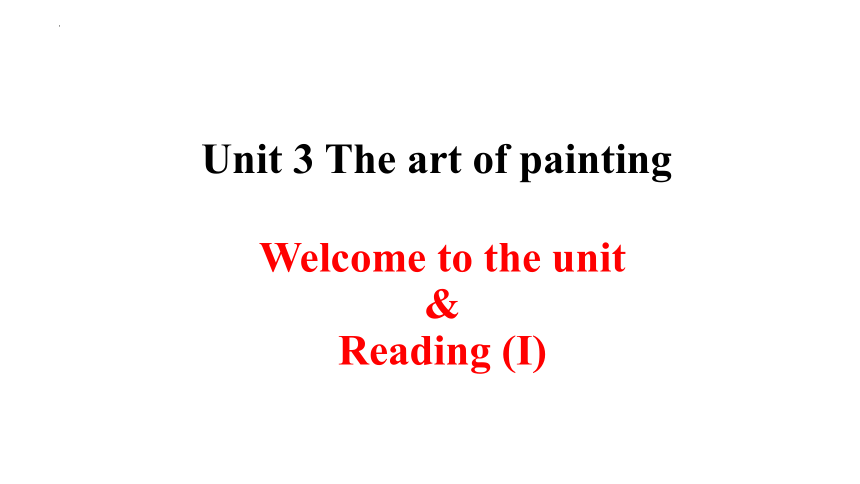 | |
| 格式 | pptx | ||
| 文件大小 | 50.7MB | ||
| 资源类型 | 教案 | ||
| 版本资源 | 牛津译林版(2019) | ||
| 科目 | 英语 | ||
| 更新时间 | 2024-01-25 16:08:02 | ||
图片预览

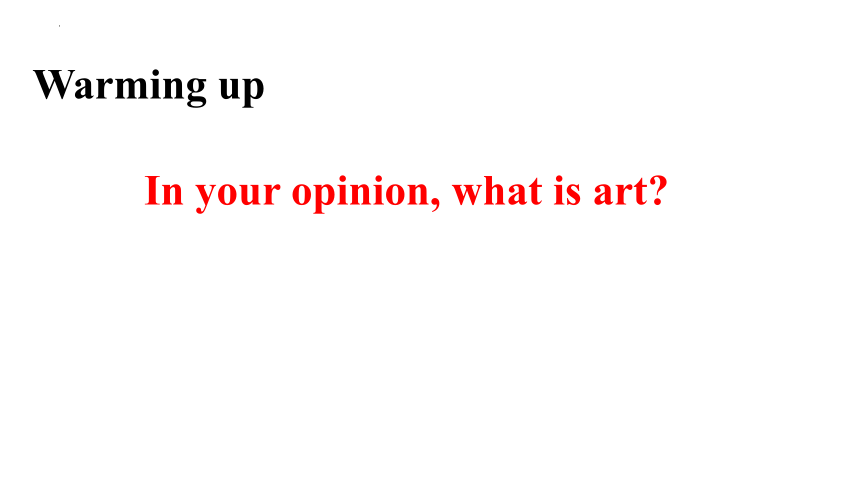
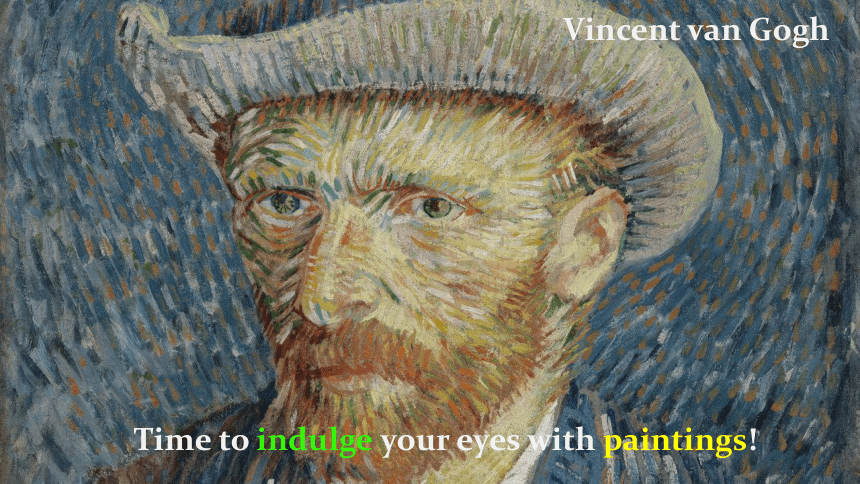
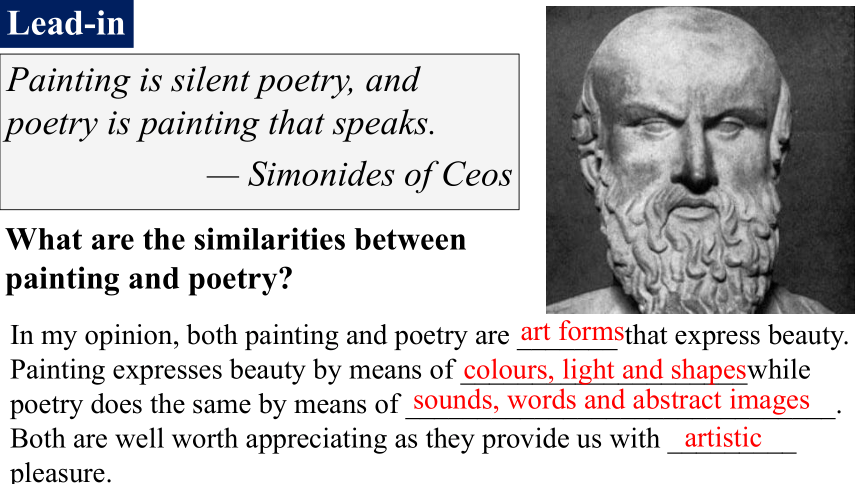


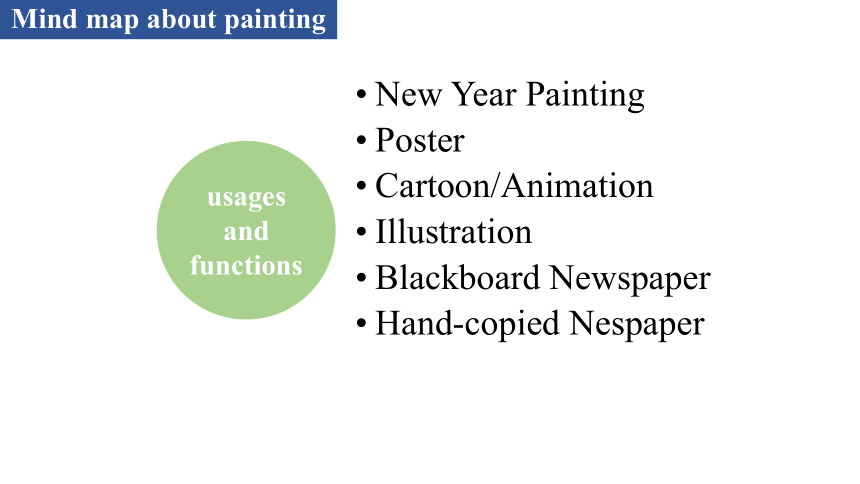
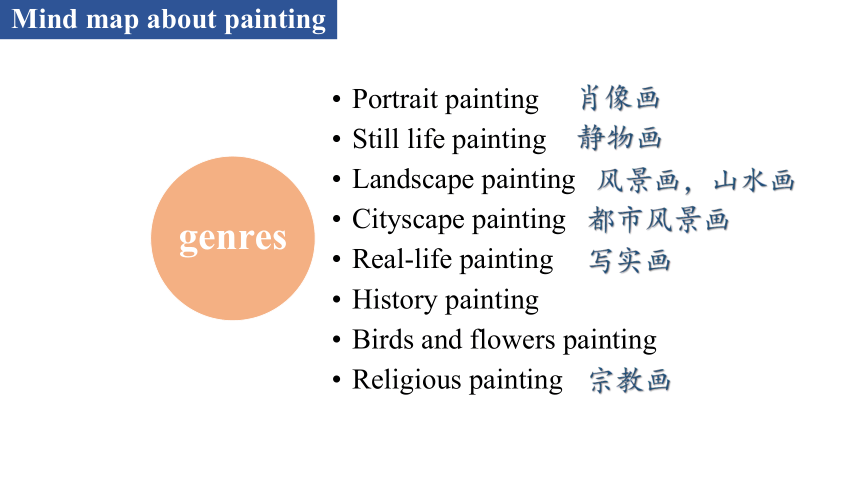
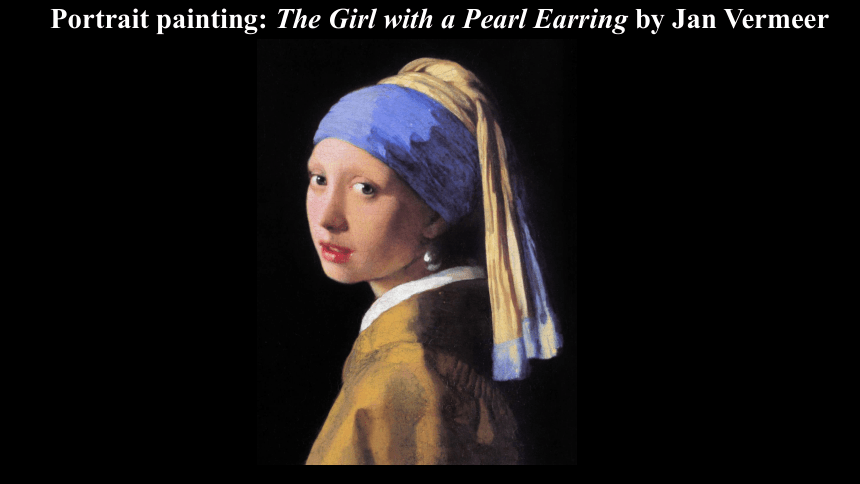
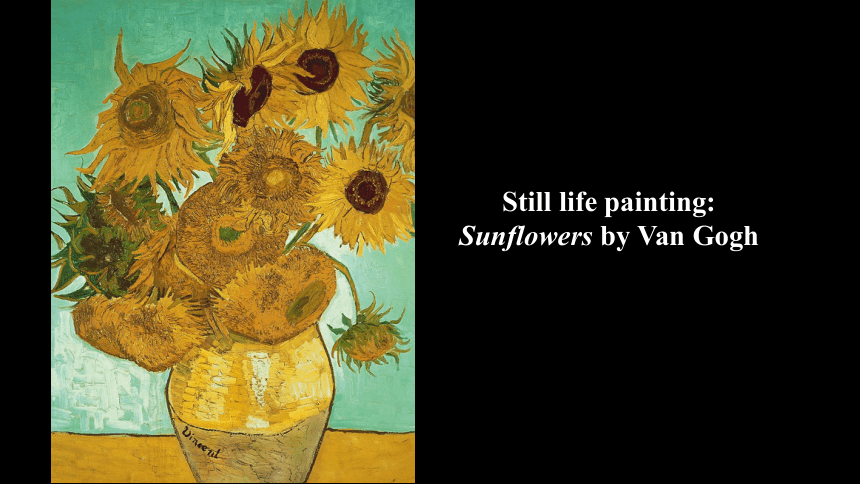
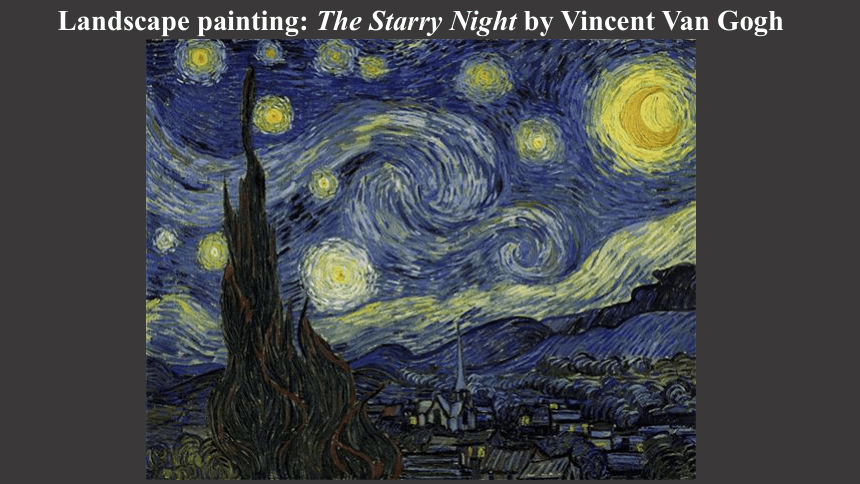
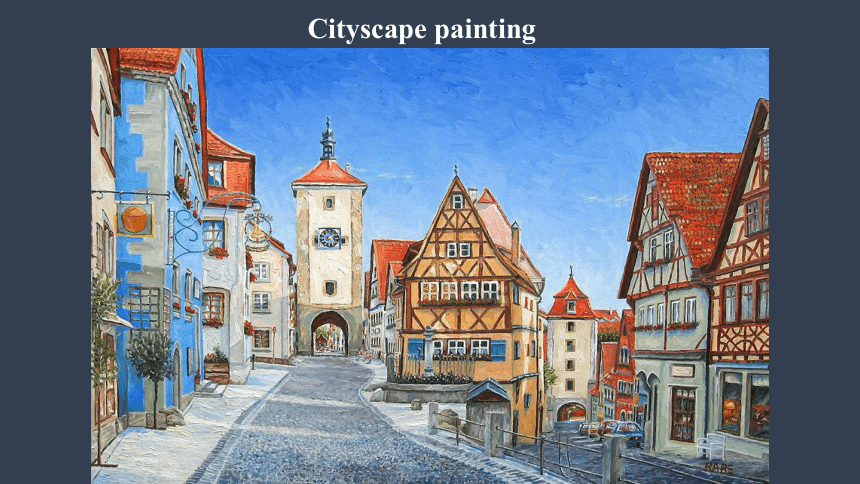
文档简介
(共68张PPT)
Unit 3 The art of painting
Welcome to the unit
&
Reading (I)
Warming up
In your opinion, what is art
Time to indulge your eyes with paintings!
Vincent van Gogh
Lead-in
Painting is silent poetry, and poetry is painting that speaks.
— Simonides of Ceos
What are the similarities between painting and poetry
In my opinion, both painting and poetry are _______ that express beauty. Painting expresses beauty by means of ____________________while poetry does the same by means of ______________________________. Both are well worth appreciating as they provide us with _________ pleasure.
art forms
colours, light and shapes
sounds, words and abstract images
artistic
Mind map about painting
painting
Mind map about painting
tools or materials used
Oils
Watercolor
Pencil
Pen
Crayon
Brush
Canvas
Mind map about painting
usages and functions
New Year Painting
Poster
Cartoon/Animation
Illustration
Blackboard Newspaper
Hand-copied Nespaper
Mind map about painting
genres
Portrait painting
Still life painting
Landscape painting
Cityscape painting
Real-life painting
History painting
Birds and flowers painting
Religious painting
静物画
风景画,山水画
都市风景画
肖像画
写实画
宗教画
Portrait painting: The Girl with a Pearl Earring by Jan Vermeer
Still life painting:
Sunflowers by Van Gogh
Landscape painting: The Starry Night by Vincent Van Gogh
Cityscape painting
Religious painting: The Last Supper by Leonardo da Vinci
Landscape painting: A Thousand Miles of Rivers and Mountains/
A Panorama of Rivers and Mountains by Wang Ximeng
Real-life painting: The Night Revels of Han Xizai by Gu Hongzhong
《韩熙载夜宴图》(南唐顾闳中)
Birds and flowers painting:
A Golden Pheasant Resting on Hibiscus Branch
《芙蓉锦鸡图》(宋徽宗画)
Ink wash painting:
Galloping Horse by Xu Beihong
《奔马图》(徐悲鸿画)
Which type do you think each of the paintings belongs to Why
Welcome to the unit
Picture 1
Picture 2
Picture 3
Picture 4
portrait
still life
real-life
landscape
Which type do you think each of the paintings belongs to Why
Welcome to the unit
Picture 1 is a portrait painting because the painting is of a person’s head and shoulders.
Picture 2 is a still life painting because the painting is of flowers that have been arranged in a vase.
Which type do you think each of the paintings belongs to Why
Welcome to the unit
Picture 3 is a real-life painting because the painter painted real people in a real situation; they are dancing and socializing.
Picture 4 is a landscape painting because the painting is of a natural view of mountains.
2. What famous painters and paintings do you know about
Welcome to the unit
Qi Baishi (1864—1957), who enjoyed painting many different animals, landscapes and still life scenes, favoured using heavy ink in bright colours and he used an energetic brushwork style.
2. What famous painters and paintings do you know about
Welcome to the unit
His famous work, Shrimps Playing
Around, is a good representation of Chinese ink paintings.Each shrimp appears to be full of life and seems to be playing around in the water. Even though the painting may appear to be simple, the distinctive features of each shrimp can be clearly recognized on close inspection.
Other paintings
2. What famous painters and paintings do you know about
Welcome to the unit
Leonardo da Vinci(1452—1519) was one of the most influential artists in the Renaissance. His most easily recognizable painting is Mona Lisa, an oil painting
that was painted sometime between 1503 and 1519.
2. What famous painters and paintings do you know about
Welcome to the unit
The half-body portrait is of a woman with a distant landscape in the background. This painting has had art experts debating for centuries about the woman’s true identity as well as the reason for her mysterious smile.
Other
paintings
The art of painting has a long history and there are many different types of paintings .
Review
History and religious painting
History and religious painting
History and religious painting
Portrait painting: The Girl with a Pearl Earring by Jan Vermeer
Still life painting:
Sunflowers by Van Gogh
Landscape painting: The Starry Night by Vincent Van Gogh
Cityscape painting
Religious painting: The Last Supper by Leonardo da Vinci
Landscape painting: A Thousand Miles of Rivers and Mountains/
A Panorama of Rivers and Mountains by Wang Ximeng
Real-life painting: The Night Revels of Han Xizai by Gu Hongzhong
《韩熙载夜宴图》(南唐顾闳中)
Birds and flowers painting:
A Golden Pheasant Resting on Hibiscus Branch
《芙蓉锦鸡图》(宋徽宗画)
Ink wash painting:
Galloping Horse by Xu Beihong
《奔马图》(徐悲鸿画)
Why do people visit art museums
Pre-reading
Why do people visit art museums
People visit art museums to appreciate the artists’ spectacular masterpieces and to be inspired by creativity. They instil(逐步感受) a sense of awe(惊叹/敬畏) that someone created something so beautiful or unique.
Visiting art museums is also one way to learn about cultures, beliefs and traditions. Art museums let us see a country’s history through its art. They are the pride of a country because they showcase its creative intelligence.
Pre-reading
The Musée d’Orsay
奥赛博物馆
Global reading: Read the travel journalland answer the following questions.
(1) What museum did the writer visit
(2) How many painters are mentioned in the journal Who are they
(3) How many paintings are mentioned in the journal What are they
Global reading: Read the travel journalland answer the following questions.
(1) What museum did the writer visit
(1) The Musée d’Orsay.
Global reading: Read the travel journalland answer the following questions.
(2) How many painters are mentioned in the journal Who are they
Four. Claude Monet, Pierre-Auguste Renoir, Vincent van Gogh and Paul Gauguin.
Global reading: Read the travel journalland answer the following questions.
(3) How many paintings are mentioned in the journal What are they
(3) Four. The Ballet Class, The Card Players,
Blue Water Lilies and Dance at Le Moulin de la Galette.
The Ballet Class by
Degas
The Card Players by Cézanne
Blue Water Lilies by Monet
Dance at Le Moulin de la Galette by Renoir
Para. 1
Global reading: Read the travel journal and write down the main idea of each
part in the chart below.
Paras. 2-4
Paras.
5-6
Read for the key words or topic sentences to help you.
Para. 1
Global Reading: Read the travel journal and write down the main idea of each
part in the chart below.
Seeing the Musée d‘Orsay was what I was looking forward to
most about my trip to Paris.
Paras. 2-4
Paras.
5-6
I was impressed by two of the greatest Impressionist painters
Claude Monet and Pierre-Auguste Renoir the most.
Impressionist painters shared some similarities in terms of their
subject matter and painting techniques, and influenced future
painters and modern art.
Detailed reading: read Para.2-4 and fill in the following table.
Claude Monet Pierre-Auguste Renoir
Famous piece 1._____________________ Dance at Le Moulin de la Galette
Subjects of painting He painted mostly scenes 2. __________________ in the last three decades of his life. He preferred to paint scenes of 5_____________________.
Other information He painted about 250 paintings of the same water lily pond, all in 3______________________. He brought the pond’s beauty to the canvas 4 ____________________. His masterpiece shows 6______________________________
________________________________.
It is characterized by the small areas of 7 _____________________ and the way the 8 __________________ seemed to mix together.
Claude Monet Pierre-Auguste Renoir
Famous piece 1._____________________ Dance at Le Moulin de la Galette
Subjects of painting He painted mostly scenes 2.________________ in the last three decades of his life. He preferred to paint scenes of 5._________________.
Other information He painted about 250 paintings of the same water lily pond, all in 3.______________________. He brought the pond’s beauty to the canvas 4. _________________. His masterpiece shows
6.________________________________________________.
It is characterized by the small areas of 7 _____________________ and the way the 8 __________________ seemed to mix together.
Blue Water Lilies
from his garden
different colours and styles
in a unique way
everyday life
life in a busy neighborhood of Paris
on a Sunday afternoon
light across the painting
soft edges of the figures
Detailed reading: read Paras. 5-6 and then complete the following tasks.
The works that came before The Impressionists’ paintings
Subjects 1 2
Styles Realistic 3
Focus 4 5
Task 2
Task 1
What influence did the Impressionists have on other painters
History paintings
Everyday subject matter
Less realistic
Just a brief “impression” they had at that moment
Every detail in a scene
The Impressionists' vision inspired a whole new generation of Post-Impressionist painters. The movement has had a lasting influence on modern art, encouraging artists to look at the world from an entirely new point of view.
What do you think of the title of this travel journal Why
The title of the travel journal is “First impressions”. I think it is a good title. It is a good summary of the artistic features of the Impressionists. The Impressionist artists did not try to paint every detail in a scene. Instead, they tried to paint a brief “impression” of the feeling they had, burning with vivid colors and light, before it disappeared. What was painted on canvas was exactly the impression in their mind at that very moment. In addition, the title also indicates that this was the first time the writer had laid eyes on real Impressionist works in a museum, since she had previously only admired them on her computer screen.
Post-reading
A3. Which of the following do you think is most likely to be an Impressionist painting Why
Impression, Sunrise.
Because it is probably a normal everyday scene for the painter. The boat and its surrounding scene are just an impression of what the painter saw so they are not painted in clear detail—the soft edges of the boats, factory chimneys, sea and sky seem to mix together. This tells me that the painter used the Impressionist free brushwork technique. The painter also used light and vivid colours to express his or her feelings.
This is Claude Monet’s masterpiece, Impression, Sunrise. This work was painted from a hotel window at Le Havre in 1872. It was one of the nine works that he showed at an exhibition in 1874. Of all those displayed there, this was probably the most famous picture because it gave rise to the name of the movement. This painting showed the treatment of light and colour that afterwards became connected with the “Impressionist” style.
Post-reading: Take a look at some facts on a masterpiece.
Notes
Name:
Painter:
Time:
Genre:
Subject:
Current location:
Influence:
Impression, Sunrise.
Post-reading: Take a look at some facts on Impression, Sunrise.
Notes
Name of the painting: Impression, Sunrise
Name of the painter: Claude Monet
Time of creation: 1872
Genre: Cityscape painting
Subject: A scene in the port of Le Havre
Current location: Paris, France
Influence: Inspiring the name of the Impressionist movement
Post-reading: List facts about another painting or painter that interests you.
Notes
Name of the painting:
Name of the painter:
Time of creation:
Genre:
Subject:
Current location:
Influence:
Finish B1 on P33.
Choose a painting or painter that impresses you most. Discuss it with your partners. Present a detailed description.
Homework
Questions:
(1) What is Vincent van Gogh’s painting style like
(2) Was Vincent van Gogh’s gift recognized during his lifetime
(1) Vincent van Gogh employed thick, unmixed paint, which resulted in vivid colours, similar to those in the Impressionist paintings. However, his works had strong lines, as opposed to the softer edges of Impressionism. He was known as a
Post-Impressionist.
(2) No. During his lifetime, Vincent van Gogh was not appreciated in the art world and he sold only one painting.
B1
Answer
(1) gallery (2) decade (3) display (4) laid eyes on
(5) employing (6) vivid (7) as opposed to (8) vision
Read the tip of “Establishing word families from root words” on page 33 and then finish B2.
Verbs Nouns Adjectives
impress impression, Impressionism, Impressionist impressive, Impressionist
dominate domination dominant
liberate liberation liberated
employ employment, employer, employee employable
influence influence influential
Where Do We Come From What Are We Where Are We Going by Gauguin
Unit 3 The art of painting
Welcome to the unit
&
Reading (I)
Warming up
In your opinion, what is art
Time to indulge your eyes with paintings!
Vincent van Gogh
Lead-in
Painting is silent poetry, and poetry is painting that speaks.
— Simonides of Ceos
What are the similarities between painting and poetry
In my opinion, both painting and poetry are _______ that express beauty. Painting expresses beauty by means of ____________________while poetry does the same by means of ______________________________. Both are well worth appreciating as they provide us with _________ pleasure.
art forms
colours, light and shapes
sounds, words and abstract images
artistic
Mind map about painting
painting
Mind map about painting
tools or materials used
Oils
Watercolor
Pencil
Pen
Crayon
Brush
Canvas
Mind map about painting
usages and functions
New Year Painting
Poster
Cartoon/Animation
Illustration
Blackboard Newspaper
Hand-copied Nespaper
Mind map about painting
genres
Portrait painting
Still life painting
Landscape painting
Cityscape painting
Real-life painting
History painting
Birds and flowers painting
Religious painting
静物画
风景画,山水画
都市风景画
肖像画
写实画
宗教画
Portrait painting: The Girl with a Pearl Earring by Jan Vermeer
Still life painting:
Sunflowers by Van Gogh
Landscape painting: The Starry Night by Vincent Van Gogh
Cityscape painting
Religious painting: The Last Supper by Leonardo da Vinci
Landscape painting: A Thousand Miles of Rivers and Mountains/
A Panorama of Rivers and Mountains by Wang Ximeng
Real-life painting: The Night Revels of Han Xizai by Gu Hongzhong
《韩熙载夜宴图》(南唐顾闳中)
Birds and flowers painting:
A Golden Pheasant Resting on Hibiscus Branch
《芙蓉锦鸡图》(宋徽宗画)
Ink wash painting:
Galloping Horse by Xu Beihong
《奔马图》(徐悲鸿画)
Which type do you think each of the paintings belongs to Why
Welcome to the unit
Picture 1
Picture 2
Picture 3
Picture 4
portrait
still life
real-life
landscape
Which type do you think each of the paintings belongs to Why
Welcome to the unit
Picture 1 is a portrait painting because the painting is of a person’s head and shoulders.
Picture 2 is a still life painting because the painting is of flowers that have been arranged in a vase.
Which type do you think each of the paintings belongs to Why
Welcome to the unit
Picture 3 is a real-life painting because the painter painted real people in a real situation; they are dancing and socializing.
Picture 4 is a landscape painting because the painting is of a natural view of mountains.
2. What famous painters and paintings do you know about
Welcome to the unit
Qi Baishi (1864—1957), who enjoyed painting many different animals, landscapes and still life scenes, favoured using heavy ink in bright colours and he used an energetic brushwork style.
2. What famous painters and paintings do you know about
Welcome to the unit
His famous work, Shrimps Playing
Around, is a good representation of Chinese ink paintings.Each shrimp appears to be full of life and seems to be playing around in the water. Even though the painting may appear to be simple, the distinctive features of each shrimp can be clearly recognized on close inspection.
Other paintings
2. What famous painters and paintings do you know about
Welcome to the unit
Leonardo da Vinci(1452—1519) was one of the most influential artists in the Renaissance. His most easily recognizable painting is Mona Lisa, an oil painting
that was painted sometime between 1503 and 1519.
2. What famous painters and paintings do you know about
Welcome to the unit
The half-body portrait is of a woman with a distant landscape in the background. This painting has had art experts debating for centuries about the woman’s true identity as well as the reason for her mysterious smile.
Other
paintings
The art of painting has a long history and there are many different types of paintings .
Review
History and religious painting
History and religious painting
History and religious painting
Portrait painting: The Girl with a Pearl Earring by Jan Vermeer
Still life painting:
Sunflowers by Van Gogh
Landscape painting: The Starry Night by Vincent Van Gogh
Cityscape painting
Religious painting: The Last Supper by Leonardo da Vinci
Landscape painting: A Thousand Miles of Rivers and Mountains/
A Panorama of Rivers and Mountains by Wang Ximeng
Real-life painting: The Night Revels of Han Xizai by Gu Hongzhong
《韩熙载夜宴图》(南唐顾闳中)
Birds and flowers painting:
A Golden Pheasant Resting on Hibiscus Branch
《芙蓉锦鸡图》(宋徽宗画)
Ink wash painting:
Galloping Horse by Xu Beihong
《奔马图》(徐悲鸿画)
Why do people visit art museums
Pre-reading
Why do people visit art museums
People visit art museums to appreciate the artists’ spectacular masterpieces and to be inspired by creativity. They instil(逐步感受) a sense of awe(惊叹/敬畏) that someone created something so beautiful or unique.
Visiting art museums is also one way to learn about cultures, beliefs and traditions. Art museums let us see a country’s history through its art. They are the pride of a country because they showcase its creative intelligence.
Pre-reading
The Musée d’Orsay
奥赛博物馆
Global reading: Read the travel journalland answer the following questions.
(1) What museum did the writer visit
(2) How many painters are mentioned in the journal Who are they
(3) How many paintings are mentioned in the journal What are they
Global reading: Read the travel journalland answer the following questions.
(1) What museum did the writer visit
(1) The Musée d’Orsay.
Global reading: Read the travel journalland answer the following questions.
(2) How many painters are mentioned in the journal Who are they
Four. Claude Monet, Pierre-Auguste Renoir, Vincent van Gogh and Paul Gauguin.
Global reading: Read the travel journalland answer the following questions.
(3) How many paintings are mentioned in the journal What are they
(3) Four. The Ballet Class, The Card Players,
Blue Water Lilies and Dance at Le Moulin de la Galette.
The Ballet Class by
Degas
The Card Players by Cézanne
Blue Water Lilies by Monet
Dance at Le Moulin de la Galette by Renoir
Para. 1
Global reading: Read the travel journal and write down the main idea of each
part in the chart below.
Paras. 2-4
Paras.
5-6
Read for the key words or topic sentences to help you.
Para. 1
Global Reading: Read the travel journal and write down the main idea of each
part in the chart below.
Seeing the Musée d‘Orsay was what I was looking forward to
most about my trip to Paris.
Paras. 2-4
Paras.
5-6
I was impressed by two of the greatest Impressionist painters
Claude Monet and Pierre-Auguste Renoir the most.
Impressionist painters shared some similarities in terms of their
subject matter and painting techniques, and influenced future
painters and modern art.
Detailed reading: read Para.2-4 and fill in the following table.
Claude Monet Pierre-Auguste Renoir
Famous piece 1._____________________ Dance at Le Moulin de la Galette
Subjects of painting He painted mostly scenes 2. __________________ in the last three decades of his life. He preferred to paint scenes of 5_____________________.
Other information He painted about 250 paintings of the same water lily pond, all in 3______________________. He brought the pond’s beauty to the canvas 4 ____________________. His masterpiece shows 6______________________________
________________________________.
It is characterized by the small areas of 7 _____________________ and the way the 8 __________________ seemed to mix together.
Claude Monet Pierre-Auguste Renoir
Famous piece 1._____________________ Dance at Le Moulin de la Galette
Subjects of painting He painted mostly scenes 2.________________ in the last three decades of his life. He preferred to paint scenes of 5._________________.
Other information He painted about 250 paintings of the same water lily pond, all in 3.______________________. He brought the pond’s beauty to the canvas 4. _________________. His masterpiece shows
6.________________________________________________.
It is characterized by the small areas of 7 _____________________ and the way the 8 __________________ seemed to mix together.
Blue Water Lilies
from his garden
different colours and styles
in a unique way
everyday life
life in a busy neighborhood of Paris
on a Sunday afternoon
light across the painting
soft edges of the figures
Detailed reading: read Paras. 5-6 and then complete the following tasks.
The works that came before The Impressionists’ paintings
Subjects 1 2
Styles Realistic 3
Focus 4 5
Task 2
Task 1
What influence did the Impressionists have on other painters
History paintings
Everyday subject matter
Less realistic
Just a brief “impression” they had at that moment
Every detail in a scene
The Impressionists' vision inspired a whole new generation of Post-Impressionist painters. The movement has had a lasting influence on modern art, encouraging artists to look at the world from an entirely new point of view.
What do you think of the title of this travel journal Why
The title of the travel journal is “First impressions”. I think it is a good title. It is a good summary of the artistic features of the Impressionists. The Impressionist artists did not try to paint every detail in a scene. Instead, they tried to paint a brief “impression” of the feeling they had, burning with vivid colors and light, before it disappeared. What was painted on canvas was exactly the impression in their mind at that very moment. In addition, the title also indicates that this was the first time the writer had laid eyes on real Impressionist works in a museum, since she had previously only admired them on her computer screen.
Post-reading
A3. Which of the following do you think is most likely to be an Impressionist painting Why
Impression, Sunrise.
Because it is probably a normal everyday scene for the painter. The boat and its surrounding scene are just an impression of what the painter saw so they are not painted in clear detail—the soft edges of the boats, factory chimneys, sea and sky seem to mix together. This tells me that the painter used the Impressionist free brushwork technique. The painter also used light and vivid colours to express his or her feelings.
This is Claude Monet’s masterpiece, Impression, Sunrise. This work was painted from a hotel window at Le Havre in 1872. It was one of the nine works that he showed at an exhibition in 1874. Of all those displayed there, this was probably the most famous picture because it gave rise to the name of the movement. This painting showed the treatment of light and colour that afterwards became connected with the “Impressionist” style.
Post-reading: Take a look at some facts on a masterpiece.
Notes
Name:
Painter:
Time:
Genre:
Subject:
Current location:
Influence:
Impression, Sunrise.
Post-reading: Take a look at some facts on Impression, Sunrise.
Notes
Name of the painting: Impression, Sunrise
Name of the painter: Claude Monet
Time of creation: 1872
Genre: Cityscape painting
Subject: A scene in the port of Le Havre
Current location: Paris, France
Influence: Inspiring the name of the Impressionist movement
Post-reading: List facts about another painting or painter that interests you.
Notes
Name of the painting:
Name of the painter:
Time of creation:
Genre:
Subject:
Current location:
Influence:
Finish B1 on P33.
Choose a painting or painter that impresses you most. Discuss it with your partners. Present a detailed description.
Homework
Questions:
(1) What is Vincent van Gogh’s painting style like
(2) Was Vincent van Gogh’s gift recognized during his lifetime
(1) Vincent van Gogh employed thick, unmixed paint, which resulted in vivid colours, similar to those in the Impressionist paintings. However, his works had strong lines, as opposed to the softer edges of Impressionism. He was known as a
Post-Impressionist.
(2) No. During his lifetime, Vincent van Gogh was not appreciated in the art world and he sold only one painting.
B1
Answer
(1) gallery (2) decade (3) display (4) laid eyes on
(5) employing (6) vivid (7) as opposed to (8) vision
Read the tip of “Establishing word families from root words” on page 33 and then finish B2.
Verbs Nouns Adjectives
impress impression, Impressionism, Impressionist impressive, Impressionist
dominate domination dominant
liberate liberation liberated
employ employment, employer, employee employable
influence influence influential
Where Do We Come From What Are We Where Are We Going by Gauguin
同课章节目录
- Unit 1 Food matters
- Welcome to the unit
- Reading
- Grammar and usage
- Integrated skills
- Extended reading
- Project
- Unit 2 The Universal Language
- Welcome to the unit
- Reading
- Grammar and usage
- Integrated skills
- Extended reading
- Project
- Unit 3 The art of painting
- Welcome to the unit
- Reading
- Grammar and usage
- Integrated skills
- Extended reading
- Project
- Unit 4 Exploring poetry
- Welcome to the unit
- Reading
- Grammar and usage
- Integrated skills
- Extended reading
- Project
